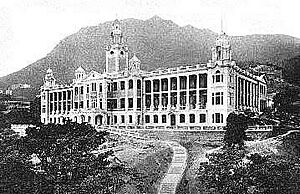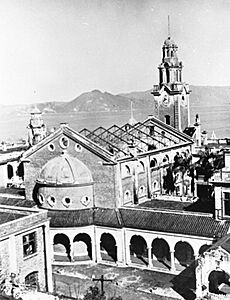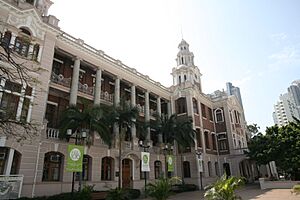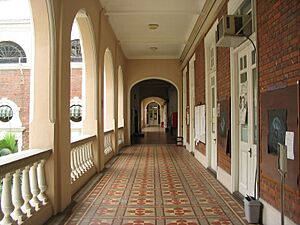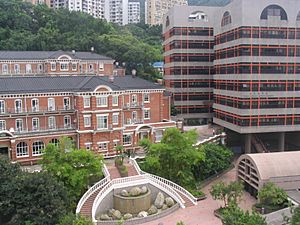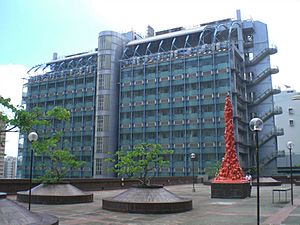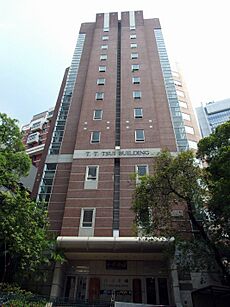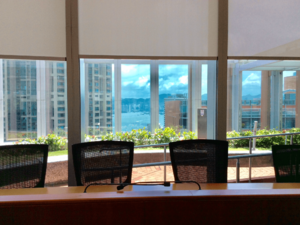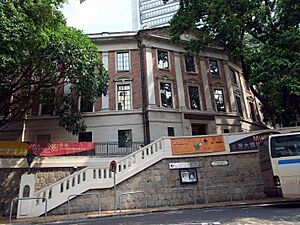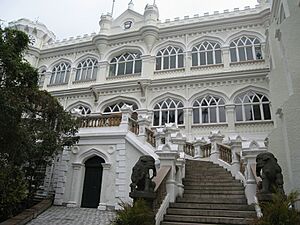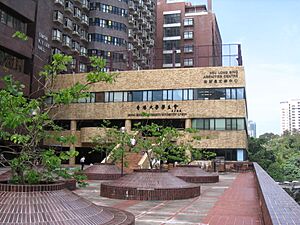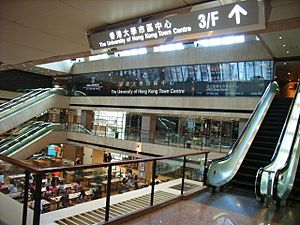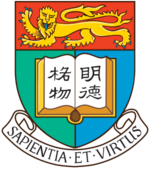University of Hong Kong facts for kids
|
香港大學
|
|||||||||||||||
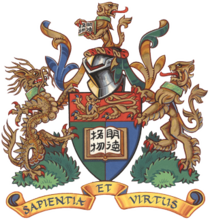
|
|||||||||||||||
| Motto | Sapientia et Virtus (Latin) 明德格物 (Classical Chinese) |
||||||||||||||
|---|---|---|---|---|---|---|---|---|---|---|---|---|---|---|---|
|
Motto in English
|
Wisdom and Virtue | ||||||||||||||
| Type | Public | ||||||||||||||
| Established | 1 October 1887 (as Hong Kong College of Medicine for Chinese) 30 March 1911 (as the University of Hong Kong) |
||||||||||||||
| Chancellor | John Lee Ka-chiu | ||||||||||||||
| President | Xiang Zhang | ||||||||||||||
| Vice-president | Gong Peng Ian Holliday Max Shen |
||||||||||||||
| Provost | Y.C. Richard Wong | ||||||||||||||
| Pro-chancellor | David Li | ||||||||||||||
|
Academic staff
|
9,288 (2023) | ||||||||||||||
|
Administrative staff
|
4,427 (2023) | ||||||||||||||
| Students | 39,166 (2023) | ||||||||||||||
| Undergraduates | 18,491 (47.2%) (2023) | ||||||||||||||
| Postgraduates | 20,675 (52.8%) (2023) | ||||||||||||||
| Location |
Pokfulam
,
Hong Kong
22°17′03″N 114°08′16″E / 22.28417°N 114.13778°E |
||||||||||||||
| Campus | Urban 17.7 hectares (0.177 km2) (Main campus) 70.1 hectares (0.701 km2) (Total) |
||||||||||||||
| Newspaper | Undergrad HKUSU (Chinese) | ||||||||||||||
| Colours | Dark green | ||||||||||||||
| Affiliations |
|
||||||||||||||
| Mascot | Lion | ||||||||||||||
 |
|||||||||||||||
| Chinese name | |||||||||||||||
| Simplified Chinese | 香港大学 | ||||||||||||||
| Traditional Chinese | 香港大學 | ||||||||||||||
|
|||||||||||||||
The University of Hong Kong (HKU) is a public research university located in Pokfulam, Hong Kong. It started in 1887 as the Hong Kong College of Medicine for Chinese. It officially became the University of Hong Kong in 1911. HKU is the oldest university in Hong Kong.
The university was created by Governor Sir Frederick Lugard. He wanted Hong Kong to have a university that could compete with other powerful countries opening universities in China. HKU is managed by three main groups: the Court, the Council, and the Senate. Each group has different jobs. The Court oversees the university, the Council manages it, and the Senate handles all academic matters.
Today, HKU has ten different academic departments, called faculties. It also has 20 places for students to live, called residential halls and colleges. English is the main language used for teaching and tests.
Many famous people have studied at HKU. One of them is Dr. Sun Yat-sen, who founded the Republic of China. He studied at the Hong Kong College of Medicine for Chinese, which was the university's earlier name. Other well-known alumni in politics include Anson Chan, Carrie Lam, Jasper Tsang, and Regina Ip.
HKU is highly rated among universities worldwide. It is currently ranked 11th by QS World University Rankings and 35th by Times Higher Education World University Rankings. It is ranked 1st in Hong Kong by both.
Contents
History of HKU
How HKU Began
The University of Hong Kong's story began with the Hong Kong College of Medicine for Chinese. This college was started in 1887 by Ho Kai (later known as Sir Kai Ho Kai). In 1907, its name changed to the Hong Kong College of Medicine. This college later became HKU's medical school in 1911.
However, it was the colony's governor, Frederick D. Lugard (1858-1945) who would be the real moving force in the creation of a university in Hong Kong... His ambitions in Hong Kong was to make the colony a more effective British asset and the creation of a university might help to fulfill this aim. Lugard's efforts reflected metropolitan development as he sought to make more recent universities (such as Birmingham and Leeds) the model for a secular institution.
The University of Hong Kong was officially founded in 1911. The governor, Sir Frederick Lugard, first suggested creating a university in Hong Kong in 1908. He wanted it to compete with other powerful countries that were opening universities in China. For example, Prussia had just opened the Tongji German Medical School in Shanghai.
Sir Lugard believed that a university would help spread British culture and influence in the Far East. He said, "We must either now take those opportunities or leave them for others to take..." Sir Hormusjee Naorojee Mody, a businessman from India, heard about Lugard's plan. He promised to donate HK$150,000 for building the university and HK$30,000 for other costs.
The Hong Kong Government and businesses in southern China also supported the idea. They wanted to learn about Western technology and success. The Government provided land. Swire Group gave £40,000 to start an Engineering department. Other donors, including the British government and companies like HSBC, also contributed. Finally, Lugard had enough money to build the university.
Charles Eliot became the university's first leader, called the vice-chancellor. Governor Lugard laid the first stone of the Main Building on March 16, 1910. The university officially opened on March 11, 1912. At first, only male students were allowed. Women were admitted ten years later.
The university started with three main departments: Arts, Engineering, and Medicine. The Faculty of Medicine was the former Hong Kong College of Medicine for Chinese. One of its most famous early students was Sun Yat-sen, who led the Chinese Revolution of 1911. This revolution changed China from an empire to a republic. In December 1916, HKU had its first graduation ceremony. There were 23 graduates and five honorary graduates.
Changes and World War II
After some strikes in 1925 and 1926, the government wanted to include more Chinese culture in education. So, in 1927, a degree in Chinese studies was created. Rich businessmen Tang Chi Ngong and Fung Ping Shan made donations. Their donations helped the university focus more on Chinese cultural education. Two buildings on campus are named after them.
In 1937, the Queen Mary Hospital opened. It has been the university's teaching hospital ever since. In 1941, during the Japanese invasion of Hong Kong, university buildings were damaged. The university closed until 1945. During this time, the medical school moved to Chengdu.
After World War II to 2001
After the Second World War, the university reopened. It started to invest more in law and social sciences as Hong Kong rebuilt. The Faculty of Social Sciences began in 1967, and the Department of Law in 1969. In 1961, there were 2,000 students. By 1980, this number grew to over 5,500.
In 1958, Mrs. Dorothea Scott, the university librarian, helped create the Hong Kong Library Association. This group was formed to support libraries in Hong Kong.
In 1982, the Faculty of Dentistry was established at the Prince Philip Dental Hospital. It is still the only place in Hong Kong that trains dental professionals. In 1984, the School of Architecture and School of Education became full faculties. The Faculty of Law was also created that year. The Faculty of Business and Economics, the university's tenth and newest faculty, was established in 2001.
After 1989, the Hong Kong government focused more on local university education. This was to encourage students to stay in Hong Kong instead of studying abroad. The number of student places and courses greatly increased before the handover of Hong Kong. By 2001, there were 14,300 students and over a hundred degree courses.
From 2001 to Today
In 2002, a book called Growing with Hong Kong: The University and Its Graduates — The First 90 Years was published. It looked at how HKU graduates have impacted Hong Kong.
In January 2006, the Faculty of Medicine was renamed the Li Ka Shing Faculty of Medicine. This was to thank Mr. Li and his Foundation for their generous donations. These donations supported the university's general development and medical research.
From 2010 to 2012, the university celebrated its 100th anniversary. During this time, the Centennial Campus opened. This new campus is at the western end of the university site in Pokfulam. The University of Hong Kong–Shenzhen Hospital, one of the university's two teaching hospitals, also opened in 2011.
On April 10, 2015, HKU became the first university in the world to join HeForShe. This is a UN Women initiative that encourages men to support women's rights. The university promised to increase the number of female deans (leaders of faculties) by 2020.
On December 15, 2017, the university's governing council chose Xiang Zhang as the new President and Vice-Chancellor. He started in January 2018. Zhang was the first vice-chancellor born in mainland China and who completed his undergraduate degree there.
On September 4, 2023, the university announced that Professor Sir Fraser Stoddart, a famous chemist and Nobel Laureate, would join as a Chair Professor. Stoddart had been a professor at Northwestern University for 16 years. His research has won many awards, including the 2007 King Faisal International Prize in Science. In 2016, he shared the Nobel Prize in Chemistry for his work on designing molecular machines. HKU sadly reported that Stoddart passed away on December 31, 2024, at age 82.
Academic Freedom Discussion
In 2015, there was a discussion about how a new leader for the university was chosen. A committee had suggested Johannes Chan for the role of pro-vice-chancellor. This role involves managing staff and resources. Chan was a well-known expert in law and human rights. He had also spoken openly about political changes in Hong Kong.
Some media outlets criticized Chan because of his political views. Usually, the university's Council accepts the suggestions from search committees for important jobs. No suggestion had ever been turned down before. However, the Council delayed the decision to appoint Chan. In September 2015, the Council voted against appointing him. They did not give a reason for their decision.
Many people thought this decision was influenced by politics. They worried it might affect academic freedom, which means professors should be able to teach and research without outside pressure. Six members of the Council are chosen by the Chief Executive of Hong Kong. The Chief Executive is also the chancellor of all public universities in Hong Kong. Some Council members are also part of the National People's Congress in Beijing.
Student groups, faculty members, and legal experts spoke out against the decision. They said it could warn other academics not to get involved in politics. They also felt it could harm Hong Kong's reputation for academic freedom. The law faculty also defended Chan against the criticisms. Billy Fung, the student union president, shared details of the Council's private meeting with the public. He was later removed from the Council.
HKU Campuses
The university's main campus is about 177,000 square metres (1,910,000 sq ft) in size. It is located on Pokfulam Road and Bonham Road in Pokfulam, and on Lung Fu Shan in the Central and Western District, Hong Kong Island. HKU also has some buildings in Sandy Bay Gap in the Southern District. Many of the university's buildings show British Colonial architecture, which is rare in Hong Kong now. The HKU MTR station, which opened in 2014, provides easy access to the campus.
The Li Ka Shing Faculty of Medicine is about 4.5 kilometers southwest of the main campus. It is in the Southern District near Sandy Bay and Pokfulam. This medical campus includes Queen Mary Hospital and research facilities. The Faculty of Dentistry is located in the Prince Philip Dental Hospital in Sai Ying Pun.
The university also runs the Kadoorie Agricultural Research Centre in the New Territories. It also has the Swire Institute of Marine Science at the tip of the d'Aguilar Peninsula on Hong Kong Island.
Main Building
The Main Building is the oldest structure at HKU. It was built between 1910 and 1912. Sir Hormusjee Naorojee Mody helped pay for it, and it was designed by Leigh & Orange. It has a special style called Edwardian Baroque, with red brick and granite. It has two courtyards. The central clock tower was a gift from Sir Paul Chater in 1930.
This building was first used for classrooms and labs for Medicine and Engineering. Later, it housed departments from the Faculty of Arts. The large central hall, called Loke Yew Hall, is named after Loke Yew, an early supporter of the university. The Main Building became a protected historical site in 1984.
Swire Building
Around 1980, the Swire Group helped fund a new student residence on the eastern side of the campus. This new hall was named Swire Building to honor their support. Mr John Anthony Swire officially opened it on November 11, 1980. In 1983, orange was chosen as the hall's color.
The hall's logo shows the letters 'S' and 'H'. The 'S' looks like two hands holding each other. This represents the hall's motto: 'Unity and Sincerity', encouraging students to work together.
Hung Hing Ying Building
This building was paid for by Sir Paul Chater, Professor G. P. Jordan, and others. It opened in 1919 and first housed the students' union. After World War II, it was used for administrative tasks. The East Wing was added in 1960. In 1974, it became the Senior Common Room. In 1986, it was named after Mr Hung Hing-Ying because his family donated to the university.
Later, it was used for administration again and housed the Department of Music until 2013. Now, it is used by the Development & Alumni Affairs Office. This two-story building has a central dome and red brick, similar to the Main Building. It became a protected historical site in 1995.
Tang Chi Ngong Building
The idea for a Chinese studies school came about between the World Wars. Construction began in 1929 after a donation from Tang Chi-ngong. The building was named after him. It was opened in 1931. Since then, more donations have helped support teaching Chinese language and literature.
The building has been used for other purposes since the 1970s, but its name remains the same. It housed the Centre of Asian Studies until 2012. Now, it houses the Jao Tsung-I Petite Ecole. This three-story building is covered with Shanghai plaster. It became a protected historical site in 1995.
Centennial Campus
To make more space for students, the Centennial Campus was built. This was needed for the new four-year undergraduate program. Construction started in late 2009 and finished in 2012. In 2012, the Faculty of Arts, the Faculty of Law, and the Faculty of Social Sciences moved to the Centennial Campus.
Academics at HKU
How to Get In
Getting into HKU is very competitive. In 2016, about 40,000 students applied for undergraduate studies. Over 16,000 of these applications were from outside Hong Kong. For students from mainland China, only 1 out of every 21 applicants was accepted.
A survey by Education18.com showed that HKU accepted students with the best results in the HKDSE exam in 2012. Internationally, students with top scores in exams like GCE A-Levels, IB, and Gaokao (from mainland China) are accepted. You can find more details about admissions on the HKU website.
Local students apply through JUPAS using their HKDSE results. Other applicants, including international students, apply directly through the official HKU website. Postgraduate applications are also made online.
Teaching and Learning
Most undergraduate degrees at HKU take four years to complete. Medical and nursing programs take longer. English is the main language used for teaching. The university's Senate has approved English as the common language on campus.
Since 2012, local students must take Academic English and Chinese language courses. However, students who are native English speakers or who did not study Chinese in high school can be excused from the Chinese course. The Chinese Language Centre offers Cantonese courses for mainland Chinese and Taiwan students. It also offers beginner Mandarin and Cantonese courses for international and exchange students.
Research at HKU
HKU is a founding member of Universitas 21, a group of research-focused universities worldwide. It is also part of other important groups like the Association for Pacific Rim Universities. HKU receives a lot of funding from the government for its research. In 2018/19, the Research Grants Council gave HKU HK$12,127 million for research. This was the highest amount among all universities in Hong Kong.
Many HKU professors are among the world's top 1% of scientists. This is based on how often their research papers are mentioned by others. HKU has the largest number of research postgraduate students in Hong Kong. They make up about 10% of all students. All ten faculties offer teaching and guidance for research students.
The University Grants Committee encourages universities to share their knowledge with the community. So, HKU created the Knowledge Exchange Office in 2010.
Libraries and Museums
HKU Libraries (HKUL) started in 1912. It is the oldest academic library in Hong Kong and has over 2.3 million items. It includes the Main Library and six special branch libraries. These are for Dentistry, Education, East Asian Languages (Fung Ping Shan), Medicine (Yu Chun Keung), Law (Lui Che Woo), and Music. They are located in different buildings on campus. You can search for books and journals using the online catalog, DRAGON.
HKUL also has digital projects that provide online access to local collections. ExamBase, launched in 1996, was the first. More digital projects are being developed to offer continuous access to digital content. It provides open access to Chinese and English academic and medical journals published in Hong Kong.
The three-story Fung Ping Shan Building was built in 1932 as a library for Chinese books. It was named after its donor. In 1962, the Chinese book collection moved to the Main Library. The building then became a museum for Chinese art and archaeology. Its collections include ceramics, pottery, and bronze sculptures. In 1996, the lower floors of the new Tsui Building were added to form the University Museum and Art Gallery.
Reputation and Rankings
| University rankings | |
|---|---|
| Global – Overall | |
| ARWU World | 69 (2024) |
| QS World | 11 (2026) |
| THE World | 35 (2025) |
| THE Reputation | 49 (2025) |
| USNWR Global | 44 (2025) |
| Regional – Overall | |
| QS Asia | 2 (2025) |
| THE Asia | 6 (2025) |
| USNWR Asia | 6 (2025) |
Overall University Rankings
HKU is highly ranked by several global university ranking systems.
- It was ranked 11th worldwide by QS in 2026.
- It was ranked 35th worldwide by THE in 2025.
- It was ranked 69th worldwide by ARWU in 2024.
- It was ranked 44th worldwide by U.S. News for 2025-2026.
The Aggregate Ranking of Top Universities (ARTU) combines these rankings. In 2023, ARTU found HKU to be the 42nd best university globally. HKU was also ranked 49th in the THE World Reputation Rankings for 2025. In 2023, Times Higher Education named HKU the most international university in the world.
Subject Rankings
QS Subject Rankings
In the QS World University Rankings by broad subject area for 2023, HKU ranked:
| Broad subject area | HKU's world rank |
|---|---|
| Social Sciences & Management | 29 |
| Arts and Humanities | 34 |
| Engineering & Technology | 79 |
| Life Sciences & Medicine | 29 |
| Natural Sciences | 81 |
THE Subject Rankings
In the Times Higher Education World University Rankings by subject for 2024, HKU ranked:
| Subject | HKU's world rank |
|---|---|
| Arts & Humanities | 54 |
| Business and Economics | 39 |
| Clinical & Health | 19 |
| Computer Science | 53 |
| Education | 6 |
| Engineering | 43 |
| Law | 20 |
| Life Sciences | 43 |
| Physical Sciences | 47 |
| Psychology | 62 |
| Social Sciences | 35 |
Graduate Job Prospects
HKU graduates are highly sought after by employers. In 2022, HKU graduates ranked 47th worldwide in the Times Higher Education's Global University Employability Ranking. They ranked 10th worldwide in the QS Graduate Employability Rankings for 2022.
Student Life at HKU
The Centre of Development and Resources for Students (CEDARS) helps students with many aspects of university life. This includes career advice, student activities, and financial support. The University Health Service provides healthcare and preventive services.
Student Population
In the 2023-2024 school year, HKU had 39,166 students. This included 18,491 undergraduate students and 20,675 postgraduate students. HKU is a popular choice for students from mainland China and other countries. In 2023, there were 19,145 non-local students, making up 47.2% of the total student body.
Student Housing
HKU has 20 residential halls and colleges. These provide housing for undergraduate students, postgraduate students, and visitors.
Some of the residential halls include:
- Main Campus: Swire Hall and Simon K. Y. Lee Hall (mainly for undergraduates). Graduate House and Robert Black College (mainly for postgraduates and visitors).
- Sassoon Road Campus: Lee Hysan Hall, Richard Charles Lee Hall, Wei Lun Hall, and Madam S. H. Ho Hall Residence for Medical Students.
- Jockey Club Student Village I (opened in 2001): Lady Ho Tung Hall and Starr Hall.
- Jockey Club Student Village II (opened in 2005): Morrison Hall, Lee Shau Kee Hall, and Suen Chi Sun Hall.
- Jockey Club Student Village III (opened in 2012): Made up of four residential colleges: Shun Hing College, Chi Sun College, Lap-Chee College, and New College. These provide 1,800 beds, with 67% for non-local students.
- Jockey Club Student Village IV: Made up of four residential colleges, providing 1,238 hostel places.
- Other older student residences include St. John's College, Ricci Hall, and University Hall.
There are also three non-residential halls:
- Hornell Hall (for males only)
- Lee Chi Hung Hall (for both males and females)
Student Groups
Two official student groups help postgraduate students get involved in activities: the Postgraduate Student Association (PGSA) and the HKU Business School Postgraduate Student Association (HKUBSPA). Undergraduate students can join student societies registered with the university's Co-Curricular Support Office (CCSO).
The Hong Kong University Students' Union (HKUSU) used to be an official student body for both undergraduate and postgraduate students. It was founded in 1912. The union is no longer officially recognized by the university. Before it was dissolved, HKUSU offered over a hundred student societies. Now, student societies are registered directly with the university's CCSO.
This organization was known for its student activism. For example, it played a big role in removing a vice-chancellor some years ago. In 2011, there was a controversy when the union's President, Ayo Chan, made comments about the Tiananmen Square protests. Many students found his comments offensive, and he was removed from his position quickly.
Study Abroad Programs
Through the Exchange Buddy Program, international students can connect with local students before they arrive in Hong Kong. These local students meet the visiting students at the airport, help them settle into their housing, and offer advice.
Every year, over 1,000 undergraduate students participate in exchange programs. They study at universities in 40 different countries. Various organizations and foundations support these programs. HKU also welcomes a similar number of students from its 340 partner universities to study on its campus each year. HKU is also part of the Laidlaw Scholars program. This program helps undergraduates do research abroad, either on their own or at other universities in the network, like University College London.
How HKU is Organized
Leadership
Chancellor
Before Hong Kong was handed over to China, the governor of Hong Kong was the official chancellor of the university. After the handover, the chief executive took on this role. The chancellor is the university's chief officer and president of the Court. However, these duties are usually handled by a pro-chancellor, who is appointed by the chancellor.
The chief executive's role as chancellor is set out in the University of Hong Kong Ordinance. If the chief executive is not available, the person acting in their place becomes the acting chancellor.
Vice-Chancellor
The vice-chancellor is the main academic and administrative leader of the university. The current vice-chancellor is Xiang Zhang.
The Court
The Court is a large group that oversees the university and makes rules. It includes members from the university and people from outside. Its purpose is to represent the wider community that the university serves. It has the power to create, cancel, and change university rules.
The Court includes:
- The Chancellor
- The Pro-Chancellor
- The Vice-Chancellor
- The Deputy Vice-Chancellor
- The Pro-Vice-Chancellors
- The Treasurer of the University
- The Registrar of the University
- Life Members
- Members of the Senate and Council
- Leaders of the Convocation (a group of graduates)
- Five members from the Legislative Council
- Twelve members from the Standing Committee of Convocation
- Five members chosen by the Court
- Three members from the Grant Schools Council
- Three members from the Hong Kong Subsidized Secondary Schools Council
- Up to twenty members appointed by the Chancellor
The Senate
The Senate is the main academic authority of the university. It is in charge of all academic matters and student welfare. Most of its 50 members are academic staff, but there are also student representatives. The vice-chancellor leads the Senate.
The Senate includes:
- The Vice-Chancellor
- The Deputy Vice-Chancellor
- The Pro-Vice Chancellors
- The Dean of each faculty
- The Chairman of each Board of the faculty
- Twelve professors
- Six teachers who are not professors
- The Director of the School of Professional and Continuing Education
- The Dean of the Graduate School
- The Librarian
- The Dean of Student Affairs
- Three full-time students (at least one undergraduate and one postgraduate)
The Council
The Council is the group that governs the university. It manages the university's money and staff, and plans for its future. The Council includes university members (staff and students) and members from outside the university. There are twice as many outside members as university members. These members serve as trustees. The current chairman of the Council is Priscilla P.S. Wong.
The Council includes:
- The Chairman of the Council
- The Vice-Chancellor of the University
- 6 people not connected to the university, appointed by the Chancellor
- 6 people not connected to the university, appointed by the Council
- 2 people not connected to the university, chosen by the Court
- The Treasurer of the University
- 4 full-time teachers
- 1 full-time university employee who is not a teacher
- 1 full-time undergraduate student
- The Secretary to the Council
The Council currently has 24 members. The chancellor can appoint the chairman of the council and six other members. The vice-chancellor is then appointed by the council.
University Departments (Faculties)
The university has ten main departments, called faculties. These are: Architecture, Arts, Business & Economics, Dentistry, Education, Engineering, Law, Science, Social Sciences, and the Li Ka Shing Faculty of Medicine. HKU also has a graduate school and other academic units. They offer many different study programs and courses. Most classes are taught in English.
HKU also runs two related institutions:
- HKU SPACE (School of Professional and Continuing Education): This was first started in 1956. It offers two-year associate degrees, diplomas, certificates, and individual courses. It also works with overseas colleges and universities.
- Centennial College: This is a liberal arts college that opened in 2012. It offers four-year bachelor's degree programs for students who have completed HKALE, HKDSE, and other exams.
Shield, Motto, and Coat of Arms
The design for the university's shield of arms was suggested in 1912. On May 14, 1913, the shield and two mottos (one in Latin, one in Chinese) were officially granted. The shield looks like the lions on the coat of arms of England. The book on the shield represents learning and knowledge. The original shield and mottos were lost during the Sino-Japanese War. New ones were obtained in 1958 for the university's 50th anniversary.
The Latin motto Sapientia et Virtus means "Wisdom and Virtue" in English. The Chinese motto on the open book has two phrases: 明德 (ming tak) and 格物 (kak mat). These mean "illustrious virtue" and "the investigation of things." The first phrase comes from a classic Confucian text, the Great Learning. The second phrase comes from the writings of Confucian scholar Zhu Xi. It talks about how wise rulers gain wisdom by investigating things.
In 1981, for the university's 70th anniversary, an application was made for a full achievement of arms. This was granted in 1984. It included the original shield and mottos, plus a crest, supporters, a helmet, and a compartment. The supporters are a Chinese dragon and a lion, representing Britain. This shows the university's goal to combine Eastern and Western cultures. The compartment represents Hong Kong Island, where the university is located. HKU is still the only university in Hong Kong with a full coat of arms.
University Mace
The Mace is a symbol of the university's authority. It is made of silver gilt, is 40 inches long, and weighs about 300 ounces. It has amber-red and green jade stones. The university's shield of arms is on the mace, surrounded by a belt with the motto. There are also four-toed Chinese dragons on both sides. The original mace was lost during the Sino-Japanese War and was replaced.
A mace bearer is chosen by the vice-chancellor to carry the mace. The current mace bearer is Dr Gordon Wong Tin Chun. The mace is carried in university ceremonies by the mace bearer. This shows the university's authority. The mace bearer always walks in front of the presiding officer.
University Anthem
The University Anthem was recorded by the Hong Kong Sinfonietta, the Diocesan Choral Society, and the former HKU Students' Union Choir (now the HKU University Choir). It was conducted by Yip Wing-sie, with new music arrangements by Dr Chan Hing-yan.
| Words in Latin | English Translation |
|---|---|
| Finis hic operum! Domus
Stat potens Academia, Unde ab occiduis recens Ampliore flust plagis Mox doctrina meatu. |
Here end our labours!
Strong stand the buildings of the University, whence modern learning soon will flow from western land in more ample course. |
| Fons ubi est sapientia?
Et, Scientia, qua lates? Pontus has negat in suis Subditas latebris, negat Has se Terra tenere. |
Where is the fountain of wisdom?
And how, O science, art thou hidden? The Sea denies that these are concealed in his hiding-place and the Earth denies that she contains them. |
| En! Dei reverentia
Hac scientia! Qui malis Abstinet, sapit. Hoc diu Munere assidue valentem Exercete iuventam! |
Lo! The fear of God–that is science!
Whoso abstains from evil, he is wise. Long and earnestly may ye train youth's vigour in this duty! |
| Pandite ostia!
Iam Deo gratias agimus. Dei semper auxilio novum Splendeat sapientiae Lumen ex Oriente! Amen. |
Fling open the gates!
Now we give thanks to God. By God's grace may the new light of wisdom ever shine out from the East! Amen. |
Famous Alumni
The University of Hong Kong has educated many famous people in different fields. One of them is Dr Sun Yat-sen, who founded the Republic of China. He was a graduate of the Hong Kong College of Medicine for Chinese, which was HKU's earlier name.
Over 40 top officials, secretaries, and council members of the Hong Kong SAR Government are HKU graduates. HKU graduates also hold senior positions in many large private companies.
In recent years, Professor Guan Yi became well-known for his research on SARS. His work helped identify the SARS-Coronavirus and its source from animal markets. This helped the Chinese Government prevent a second SARS outbreak in early 2004.
See also
 In Spanish: Universidad de Hong Kong para niños
In Spanish: Universidad de Hong Kong para niños
- Vice-Chancellors of the University of Hong Kong
- Education in Hong Kong
- Hong Kong University Students' Union
- List of buildings and structures in Hong Kong
- List of higher education institutions in Hong Kong
- List of oldest universities in continuous operation
- The University of Hong Kong Faculty of Law
- The Asian Institute of International Financial Law


